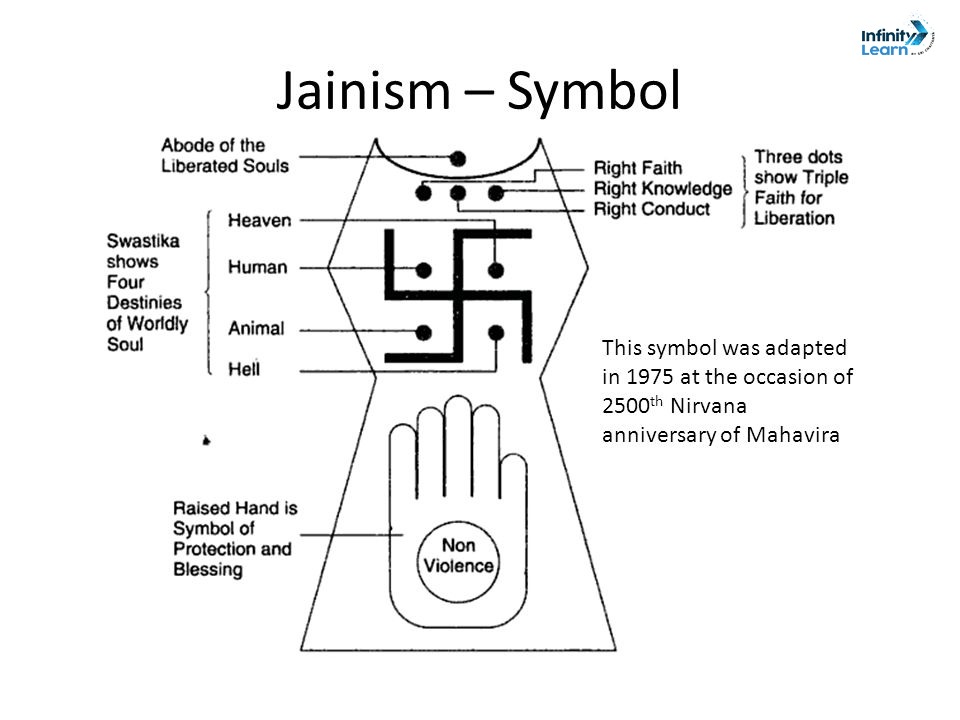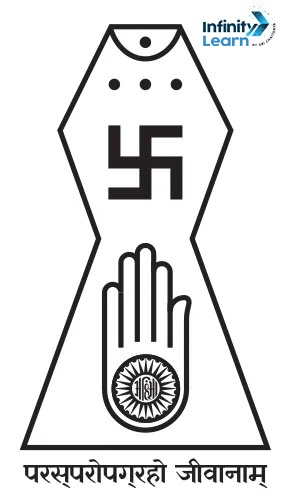Table of Contents
The Jainism symbol reflects the ancient Indian religion’s core principle of non-violence towards all living beings. It’s a visual representation of Jain teachings, emphasizing compassion and respect for life. This symbol underscores Jainism’s commitment to harmony and interconnectedness among all sentient beings, promoting a peaceful way of living.
Jainism Symbol

Jainism, one of the ancient religions of India, is rich in symbolism that encapsulates its profound spiritual values and philosophical teachings. Among the various symbols revered in Jainism, the swastika and the emblem of Ahimsa hold paramount significance, representing the core principles of this non-violent faith. Let’s delve into the meaning and significance of these symbols and how they reflect Jain values.
Also Check: Symbol Name
The Swastika: Symbol of Cosmic Order
The swastika holds significant prominence as a symbol in Jainism. Far from its misappropriated connotations in the 20th century, the swastika in Jainism holds a deep, spiritual meaning. Its four arms represent the four states of existence:
- Heavenly beings (devas)
- Human beings
- Hellish beings
- Tiryancha (subhuman creatures such as flora and fauna)
These four states illustrate the perpetual nature of the universe in the material world, governed by karma. Each being transitions through these states based on their karmic actions, symbolizing the cycle of birth, death, and rebirth.
Above the swastika are three dots, representing the three jewels of Jainism (Ratnatraya):
- Right Faith
- Right Knowledge
- Right Conduct
These jewels guide an individual towards liberation (moksha), which is symbolized by the crescent and dot at the top of the swastika. Together, these elements illustrate the path from the transient, imperfect world to a state of eternal bliss and enlightenment.
The swastika also symbolizes the four pillars of the Jain Sangha:
- Sadhus (monks)
- Sadhvis (nuns)
- Shravakas (male lay followers)
- Shravikas (female lay followers)
Moreover, it represents the four infinite characteristics of the soul: infinite knowledge, infinite perception, infinite happiness, and infinite energy.
Also Check: How to Make and Draw a Swastik
Ahimsa: The Principle of Non-Violence

The symbol of Ahimsa, central to Jain philosophy, is depicted as a hand with a wheel on the palm. The word “Ahimsa” in the middle signifies non-violence. The wheel, or dharmachakra, represents the resolve to halt the cycle of saṃsāra through the relentless pursuit of Ahimsa. This symbol promotes the fundamental Jain doctrine of non-violence towards all living beings.
The Jain Emblem: A Comprehensive Symbol
In 1975, on the 2500th anniversary of Lord Mahavira’s nirvana, the Jain community adopted a comprehensive emblem that embodies many core Jain concepts. The emblem’s outline represents the universe as described in Jain scriptures, divided into three realms:
- Heaven (upper portion)
- The material world (middle portion)
- Hell (lower portion)
The semi-circular topmost portion symbolizes siddhashila, the realm of liberated souls. The three dots under this semi-circle represent the Ratnatraya. The swastika symbol is placed in the top portion, reinforcing its significance.
The hand at the bottom of the emblem, with a circle in the middle, represents fearlessness and Ahimsa. The circle symbolizes the cycle of saṃsāra, and the 24 spokes stand for the teachings of the 24 Tirthankaras, guiding souls towards liberation.
The mantra at the bottom, “Parasparopagraho Jivanam,” translates to “All life is bound together by mutual support and interdependence,” highlighting the interconnectedness of all life forms.
Jain Flag and Its Colors

The Jain flag, another important symbol, consists of five colors representing the Pañca-Parameṣṭhi and the five vows:
- White – symbolizes the Arihants, souls who have achieved omniscience.
- Red – represents the Siddhas, liberated souls.
- Yellow – denotes the Acharyas, master teachers.
- Green – stands for the Upadhyayas, those who teach the scriptures.
- Dark Blue – signifies the Munis, the ascetics.
Each color also represents a specific virtue, such as non-violence (Ahimsa), truthfulness (Satya), non-stealing (Achaurya), chastity (Brahmacharya), and non-possession (Aparigraha).
Om in Jainism
In Jainism, “Om” is a sacred syllable that condenses the essence of the Pañca-Parameṣṭhi (the five supreme beings: Arihants, Siddhas, Acharyas, Upadhyayas, and Munis). This powerful symbol represents the Navakar Mantra, the most important prayer in Jainism, which honors these supreme beings.
According to the Dravyasamgraha, a Prakrit line describes it as follows:
“ओम एकाक्षर पञ्चपरमेष्ठिनामादिपम् तत्कथमिति चेत “अरिहंता असरीरा आयरिया तह उवज्झाया मुणियां”
“oma ekākṣara pañca-parameṣṭhi-nāmā-dipam tatkabhamiti ceta “arihatā asarīrā āyariyā taha uvajjhāyā muṇiyā”
In essence, Aum is composed of the initials of the five Parameshthis:
A = Arihanta
A = Ashiri (Siddha)
Ā = Acharya
U = Upadhyaya
M = Muni (Sadhu)
Thus, “ओं नमः” (Om Namah) serves as a concise form of the Navkar Mantra.
Jainism Symbol Images

Ashtamangala: The Eight Symbols of Jainism
In Jainism, the Ashtamangala, or eight auspicious symbols, are highly revered. The Ashtamangala are eight auspicious symbols integral to Jain ritual and iconography. These symbols differ slightly between the two main sects of Jainism: the Digambara and Śvētāmbara traditions. Here’s a simplified look at these symbols and their meanings:
Digambara Tradition
Parasol (Chatra): Represents protection and honor.
Flag (Dhvaja): Symbolizes victory and spiritual dominance.
Pot (Kalasha): Denotes prosperity and auspiciousness.
Fly-whisk (Chamara): Signifies respect and high status.
Mirror (Darpan): Represents self-awareness and truth.
Throne (Bhadrasana): Symbolizes spiritual authority.
Hand Fan (Vyalambara): Indicates the spread of spiritual knowledge.
Vessel (Ghatta): Denotes purity and abundance.
Śvētāmbara Tradition
Swastika: Represents the four states of existence (heavenly beings, human beings, hellish beings, and animals/plants).
Srivatsa: Symbolizes the heart of enlightened beings.
Nandavarta: Represents the intricate path of spiritual progress.
Food Vessel (Vardhmanaka): Denotes prosperity and well-being.
Seat (Bhadrasana): Symbolizes wisdom and spiritual authority.
Pot (Kalasha): Represents abundance and purity.
Mirror (Darpan): Signifies self-reflection and truth.
Pair of Fish: Represents fearlessness and spiritual liberation.
These symbols are integral to Jain rituals and ceremonies, embodying core Jain values such as non-violence, truth, purity, and spiritual knowledge. They serve as reminders of the principles that guide Jains on their path to enlightenment.
Also Read: Essay on Jainism
Conclusion
In conclusion, Jain symbols are rich with meaning and profoundly reflect the religion’s core values of non-violence, spiritual liberation, and ethical living. They serve as visual reminders of the path to enlightenment and the principles that guide Jain practitioners in their daily lives.
Jainism Symbol FAQs
What are the symbols of Jainism?
Jainism's symbols include the Jain emblem, the swastika, and the Ashtamangal. The emblem features a hand with a wheel on the palm, representing non-violence and the cycle of birth and rebirth. The swastika signifies the four realms of existence. The Ashtamangal are eight auspicious symbols that hold significant religious importance.
What is the holy animal of Jainism?
In Jainism, the cow is honored as a sacred animal. It symbolizes non-violence and respect for all living beings, reflecting the core Jain principle of ahimsa (non-violence).
What are Jainism beliefs?
Jainism is centered on five main principles: non-violence (ahimsa), truth (satya), non-stealing (asteya), chastity (brahmacharya), and non-possessiveness (aparigraha). Jains believe in karma, the cycle of birth and rebirth, and the pursuit of liberation (moksha) through ethical living and self-discipline.
What is the flag of Jainism?
The Jain flag has 5 colors: white, red, yellow, green, and blue. Each color represents different values and principles. White stands for purity, red for truth, yellow for non-violence, green for non-attachment, and blue for knowledge.
What is the significance of Ashtamangal in Jainism?
The Ashtamangal refers to eight auspicious symbols in Jainism, which include the swastika, srivatsa, nandavarta, vardhamanaka, kalasha, minayugala, darpana, and bhadrasana. These symbols are used in religious rituals and art to represent various spiritual and philosophical concepts.







